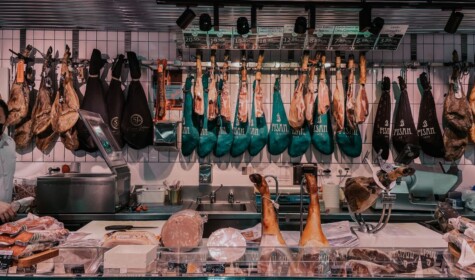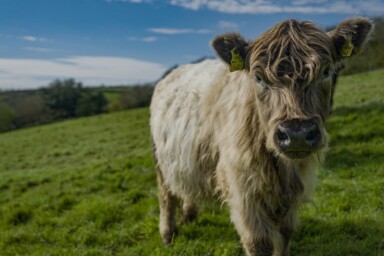When was the last time you bought meat at a high street butcher’s shop? Chances are that it’s been a while, either because the butcher’s shop near you closed down years ago or because it’s simply easier to pick up meat and sausages when you do your weekly shopping at a supermarket.
For consumers, shopping at a supermarket has advantages: finding everything you need in one place makes it fast and convenient, usually there is plenty of parking space available and opening hours are longer than those of specialist shops such as high street bakers, butchers or fishmongers. A big enough branch of a supermarket will have a fresh meat counter, but mostly shoppers grab whatever they need from the coolers, portioned and neatly packed. In the last 12 months UK consumers bought 600 million kilos of beef, 84 million kilos of lamb and 1 billion kilos of pork, spending just over £11 billion – most of it in supermarkets.
Such convenience for consumers has consequences for farmers and processors: supermarkets need large volumes of product, fast and on demand. As a result, supply chains have become shorter and more centralised. Abattoirs have become much bigger and specialise in killing one or two species. Hundreds of head of cattle or pigs can be slaughtered and processed in a day. This efficiency reduces not just costs but also paperwork and the need for highly trained staff: the processing of an animal is broken down into many dozens of single movements performed by as many dozens of workers on an assembly line. Each movement has to be fast and precise, but it can be learnt on the job, you don’t have to be a trained butcher to repeat the same cut over and over. Small abattoirs with a team of trained butchers cannot compete on price and over the past 10 years many have had to close down. In 2021, just under 90% of beef cattle were killed in 31 medium and larger abattoirs, and 98% of sheep were killed in 57 medium and larger abattoirs. Only 5.4% of cattle and 0.7% of sheep were killed in smaller abattoirs.
Why is this a problem?
With fewer and fewer abattoirs, animals have to be transported further to slaughter – a journey that is often stressful and uncomfortable for the animals, in particular those who have spent all their lives within the same herd, grazing. But the problems reach much deeper: big abattoirs need a constant supply of ‘cookie cutter’ animals that are pretty much the same size and weight. Similar to the chassis of a car, the carcase moves along an assembly line, the main difference being that cars are assembled and carcases ‘disassembled’. For a worker to repeat one task often dozens of times per minute, the ‘parts’ must not vary much in shape and size.
We witnessed last autumn what happens when pigs don’t have their ideal slaughter weight. Because of severe worker shortages, the slaughter capacity at abattoirs was greatly reduced, and pork producers had to keep many animals on farm and continue feeding them. Very soon, the lack of space caused animal welfare concerns, but in addition, many pigs also grew too large for an abattoir to handle and had to be culled, their meat never entering the food chain. It’s not that the meat of a 300 kilo sow (the ‘normal’ slaughter weight is about 120 kilos) couldn’t be delicious – the fat of a grown pig is actually essential for making high value products such as salami. The problem is that only a fully trained butcher will have the very specific skills to slaughter and process such a large pig, which wouldn’t even fit onto the assembly line of a big slaughter facility.
The industry’s need for ‘same size’ animals has shaped the way they are raised: UK supermarket beef, for example, might be born and raised on a conventional beef farm in rural West Wales, where the fields are sown with artificial fertiliser, and to increase growth rates, the cattle are fed supplementary concentrate feed, including genetically modified soya imported from Brazil. When it’s time for slaughter, a haulier collects these animals and transports them 170 miles to an abattoir in Lancashire. The meat products are then distributed across the UK to supermarket shelves, possibly even returning to a supermarket shelf in rural West Wales.
This system has huge environmental implications such as emissions from transport and the use of imported protein sources such as GM soya, which is having a devastating effect on rainforests in South America. Other feed grains are grown in the UK under intensive arable systems that have become biodiversity deserts.
It could be so different
And yet, the British Isles in large parts are predestined for growing grass and keeping livestock. If grazing on permanent pastures is well managed (the pasture is neither over nor undergrazed), little or no chemicals are needed and there is no need to import soy. Arable land then becomes available to grow food for humans.
From shaggy Highland Cattle to the tiny Dexters, from hardy Romney sheep to woolly Blue Face Leicesters, Britain is home to a wealth of cattle and sheep breeds, each of which does particularly well under specific topographic and climatic conditions but all very different in looks, size and weight. In a well managed system, these animals are not only effective ‘land-managers’ delivering environmental benefits, they could also be a source of healthy, nutritious and local food – if only the farmers had access to a local abattoir. Which, increasingly, they don’t.
Our food system is based on industrial food production, centralised supply chains, just in time delivery and supermarkets stocked with cheap food. What’s rarely talked about is how easy it is to cheaply produce highly processed foods with low nutritional value such as sugary cereal, not just because of the relatively low value of the ingredients, but also because the costs to the environment and to our health are not factored in. Food manufacturers do not pay for the emissions caused by transport, fertiliser and pesticide use, nor for the healthcare costs arising from diabetes and obesity. As Nicolette Hahn Niman explains in her book Defending Beef, consuming small amounts of sustainably produced meat from grass-fed animals has health benefits as well as benefits for the environment and local and rural economies.
From farm to fork via your local supermarket?
Given the way our food system works, it is unsurprising that consumers have lost the connection with where their meat is coming from. Very little produce can be traced from farm to fork. Education and information would help. But how do we get sustainably produced local food, meat in particular, to consumers? The pandemic has shown that at a local level, farmers and local food shops were able to adapt very quickly and react to the demands of customers providing local food to local families. But most of us shop in supermarkets. Supermarkets control British food retail and have the single biggest role to play in improving food supply chains and the national diet. As huge buyers from the farming sector, these corporations wield an overwhelming degree of power over their suppliers.
It’s not all bad news, some tentative steps have been taken: in Wales, Lidl has a range of Welsh beef products on the shelves as part of their ‘commitment to supporting local farmers’. According to the industry website Sterling Choice, Morrisons claims they are moving to sourcing only British meat: “In July, it was announced that Morrisons was to become the first UK supermarket to commit to only selling British meat, and would stop selling imported fresh meat, such as lamb from New Zealand, which it has previously done during the winter months.” How far this meat travels within the UK is a different matter.
Waitrose told me in an email: “All of our fresh lamb, pork (including bacon), beef and chicken are UK sourced and come from local farmers we know and trust.” In another email, Waitrose said the data on which farm delivers what meat were recorded internally: “(We) have full traceability from farm to shelf and can trace each piece of meat back to farm…We also submit [this information] to Business Benchmark and Farm Animal Welfare (BBFAW).” BBFAW has given Waitrose Tier 1 status, but again, there is no way of knowing how far the animals had to travel to an abattoir.
Possibly, farmers could do – and are doing – more, too. Just last week, a group of farmers together with a butcher launched ‘The Good Beef Index’, a label that scores meat quality, its environmental footprint and the conditions under which it was raised. “We want to bring consumers and beef farmers together,” says Ian Warren who runs the family’s butcher’s shop in Launceston in Cornwall. He worries about the future supply of the highest quality beef from local farmers: if we want farmers to raise animals sustainably and produce excellent quality meat, we have to make sure the farms are financially viable, he says. For him, it is about educating consumers and he hopes the Good Beef Index will create demand, because only then will retailers stock it. “This has to be consumer driven,” says Warren. How will he and his farmer colleagues get consumers interested in yet another label? For a start, endorsements by well known chefs may help – 70% of Warren’s business is meat supply to restaurants – but in the end this is a long-term project.
Networking is essential – whether it is through informal groups, co-ops or associations – farmers who are part of a group that aims to facilitate slaughter, transport and marketing will be in a better position to get their meat onto the shelves of retailers. They could work with distributers who would be able to deliver orders via EDI (electronic data interchange) which would open up the choice to consumers who would like to buy more locally produced products but can’t make the leap to changing their shopping habits to buying all meat in a butchers or at (online) farm shops. With this method, supermarkets could also allow shelf space for locally produced, unprocessed meat products. Another option would be to bring the local butcher into the supermarket, where they could sell locally sourced meat with the expertise only a trained butcher has. On the continent, the ‘shop in shop’ model works well at least for bakeries.
Even with a strong demand for local, sustainably produced meat, at present all efforts to increase the supply are hampered by regulatory burdens, unfavourable planning laws and staff shortages. For local, sustainable meat to reach supermarket shelves, we need a network of small abattoirs where well trained and well paid butchers are able to humanely slaughter and process not just different species, but animals of varying size, age and temperament.







